AMD Carrizo Part 2: A Generational Deep Dive into the Athlon X4 845 at $70
by Ian Cutress on July 14, 2016 9:00 AM ESTMiddle-Earth: Shadows of Mordor
The final title in our testing is another battle of system performance with the open world action-adventure title, Shadows of Mordor. Produced by Monolith using the LithTech Jupiter EX engine and numerous detail add-ons, SoM goes for detail and complexity to a large extent, despite having to be cut down from the original plans. The main story itself was written by the same writer as Red Dead Redemption, and it received Zero Punctuation’s Game of The Year in 2014.
For testing purposes, SoM gives a dynamic screen resolution setting, allowing us to render at high resolutions that are then scaled down to the monitor. As a result, we get several tests using the in-game benchmark, taking results as the average and minimum frame rates.
For this test we used the following settings with our graphics cards:
| Shadow of Mordor Settings | |||
| Resolution | Quality | ||
| Low GPU | Integrated Graphics | 1280x720 | Low |
| ASUS R7 240 1GB DDR3 | |||
| Medium GPU | MSI GTX 770 Lightning 2GB | 1920x1080 | Ultra |
| MSI R9 285 Gaming 2G | |||
| High GPU | ASUS GTX 980 Strix 4GB | 1920x1080 3840x2160 |
Ultra Ultra |
| MSI R9 290X Gaming 4G | |||
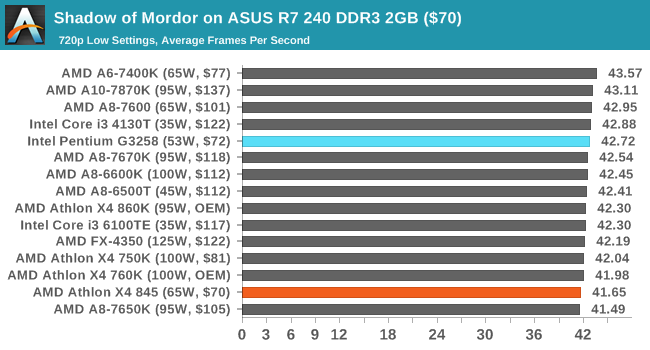
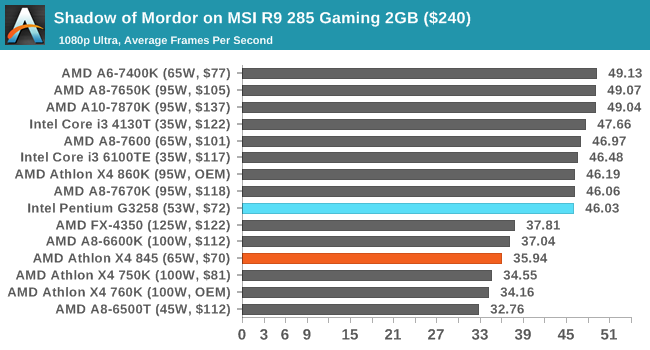

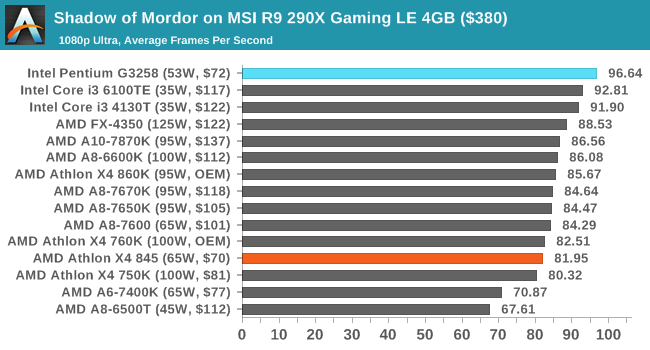
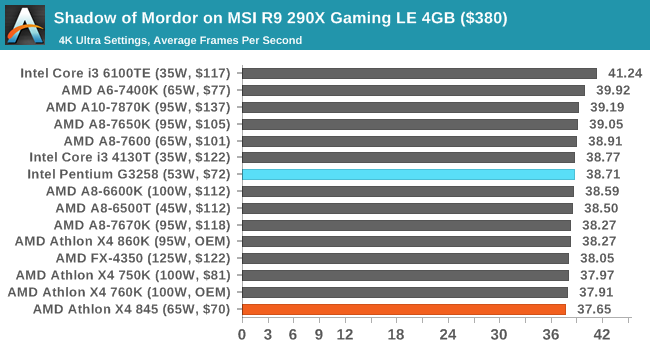
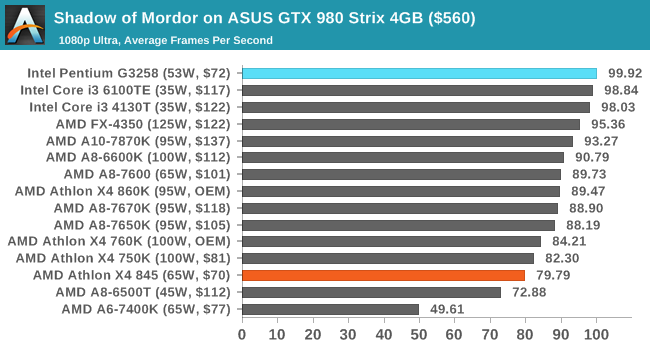
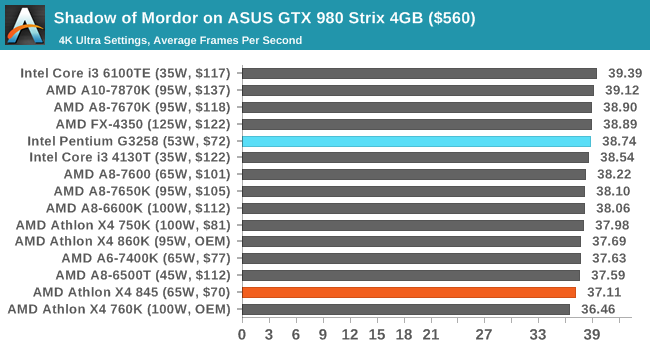
Shadow of Mordor, in all cases except the GTX 770, puts the Pentium ahead of the Carrizo part. In a couple of circumstances, this doesn't matter much, particularly at 4K resolutions with the R9 290X and GTX 980, however at 1080p the Pentium comes out ahead.
![Shadow of Mordor on ASUS R7 240 DDR3 2GB ($70) [Minimum FPS]](https://images.anandtech.com/graphs/graph10436/82717.png)
![Shadow of Mordor on MSI R9 285 Gaming 2GB ($240) [Minimum FPS]](https://images.anandtech.com/graphs/graph10436/82725.png)
![Shadow of Mordor on MSI GTX 770 Lightning 2GB ($245) [Minimum FPS]](https://images.anandtech.com/graphs/graph10436/82735.png)
![Shadow of Mordor on MSI R9 290X Gaming LE 4GB ($380) [Minimum FPS]](https://images.anandtech.com/graphs/graph10436/82745.png)
![Shadow of Mordor on MSI R9 290X Gaming LE 4GB ($380) [Minimum FPS]](https://images.anandtech.com/graphs/graph10436/82747.png)
![Shadow of Mordor on ASUS GTX 980 Strix 4GB ($560) [Minimum FPS]](https://images.anandtech.com/graphs/graph10436/82755.png)
![Shadow of Mordor on ASUS GTX 980 Strix 4GB ($560) [Minimum FPS]](https://images.anandtech.com/graphs/graph10436/82757.png)
Minimum frame rates for Shadow of Mordor are even more in favor of the Pentium here, and with the low-to-mid range graphics cards (R7 240, R9 285, GTX 770) the effect can be up to double the minimum frame rate over the Athlon.











131 Comments
View All Comments
Chaser - Friday, July 15, 2016 - link
Yeah lets celebrate another year of 10 or so of AMD's paper launches of incredible CPUs. Bulldozer was awesome dude!Dr. Swag - Thursday, July 14, 2016 - link
Yes, the review is finally here! Yes!nandnandnand - Thursday, July 14, 2016 - link
A review for a chip nobody should buy, because it's much worse than Zen will be.Laxaa - Thursday, July 14, 2016 - link
I wish there was a AM3+ version of Zen for us stuck on that platform. I'm not that interessted in getting a new motherboard(perhaps I should have stuck with Intel instead)Peichen - Thursday, July 14, 2016 - link
You should have stuck with Intel. I buy into AMD's upgrade CPU, motherboard at different time scheme and is now stuck with a hot old CPU and a quite new motherboard with unreliable RAID controller. Junk the whole system means I toss out a 1.5 years old motherboard. Upgrade the CPU means not much performance increase and when the board's RAID fail I will have to buy AMD again so I won't throw out a new CPU.I wish I pay slightly more for an i3 or i5 and have a reliable media/light-gaming system for 6 years without all the hassle.
just4U - Thursday, July 14, 2016 - link
well.. then you'd have been stuck with a socket 1156 cpu and no board to go with it.. Intel's gone thru what.. 5 socket changes during the last 6-7 years.. There's something to be said for throwing a 2009 cpu into a 2016 board, and it's easy enough to (at some point..) change over to one of their newer processors in that lineup.It's also a hit/miss on any hardware. While some go the distance lasting a long time .. other's fail and it's not exclusive to either platform. I use processors from both camps. +/- for both. Just depends what your using your system for and what your expecting to get out of it.
pats1111 - Thursday, July 14, 2016 - link
I don't know why you're whining about a 1.5 year old mainboard. Typically, your NORMAL computer enthusiast is upgrading everything every 2 to 3 years. You have the same issues with Intel, platform changes occur every 1.5 years, and you're stuck with your "old, hot" processor. Wake up and embrace the technological advancement in front of you...Nagorak - Monday, July 18, 2016 - link
What advancement?artk2219 - Wednesday, July 20, 2016 - link
Ding ding ding, we have the real question. Sure skylake is faster than sandy bridge, but compared to the advancement that 4 years used to make in chip tech, its nothing. An average of 25% IPC increase, most of which you can get back by bumping the clocks 30%, which most sandy bridge chips would do easily. Granted with skylake chip is more efficient, with more features, and better a igp, and blah blah blah. But honestly, for most things you would never notice, and dont even get me started on how pointless DDR4 is currently. But even that atleast will mature with time, unfortunately I'm sure you'll need another new socket to really realize its benefits.http://www.anandtech.com/show/9483/intel-skylake-r...
http://www.anandtech.com/show/9483/intel-skylake-r...
wiboonsin - Monday, July 10, 2017 - link
What a great blog. I like the way you see http://www.dicksrunningshop.com/ . Thank you!